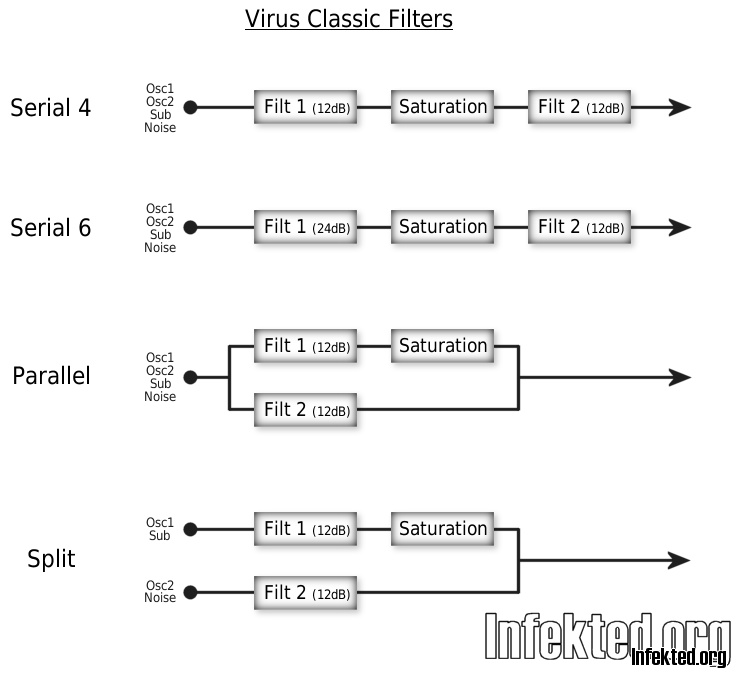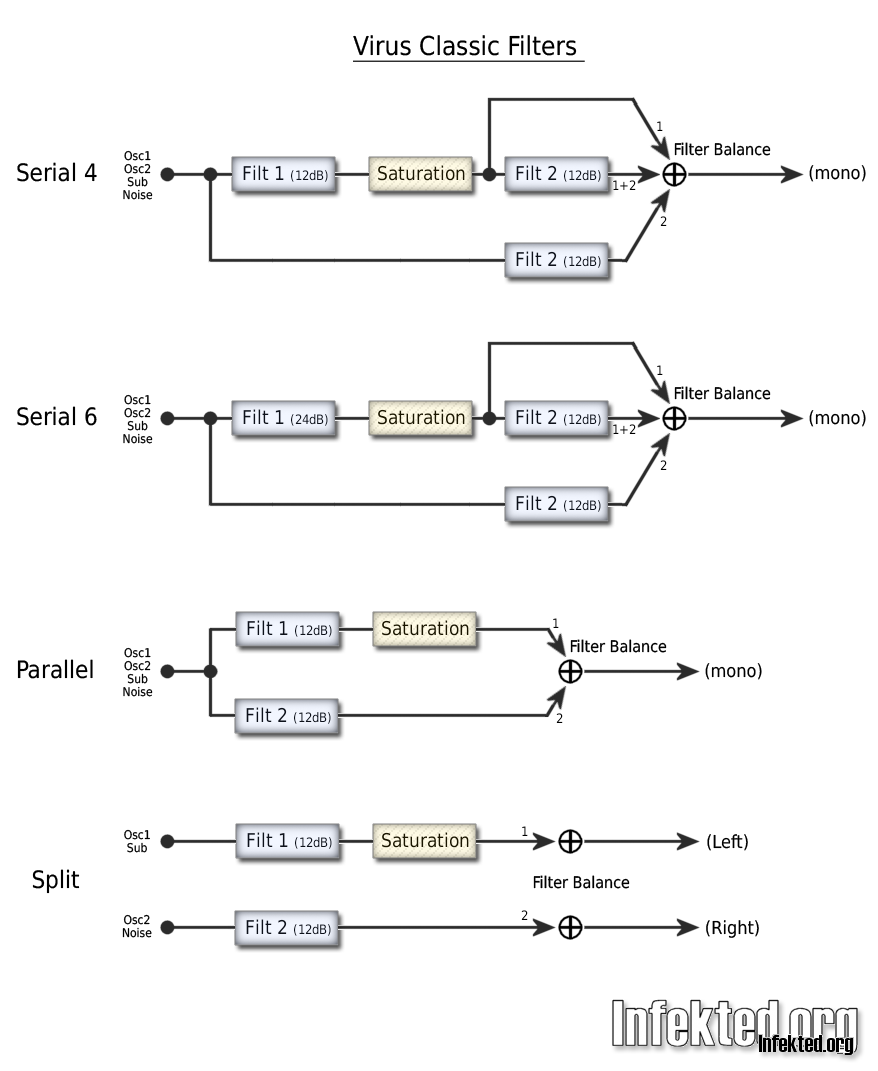
 |
Filter Routing on Virus C
Hi!
I just wondered if someone could give me a couple of good applications to what you could use the serial but most of all the parallel-filter-routings of Virus C to. I mostly get the serial filters but anyway want some good examples for use there but the parallel routings of the filters are more unclear what you can use them to. So please many filter-parallel-examples and a few serial too. Thanks in advance!! //Black Celebration |
|
Thanks but that is split mode where it is different sources on the different lines of filtering and they dont mix up toghether in the end either like in the parallel mode. They are alike though but i dont know if they due to this are fully comparable. But there are similarities anyway so it is a start.
|
 Shows the basic routing. Notice how Split mode splits the oscillator inputs to each filter. This can wield some really dynamic results when modulated independently. It's almost like having two different patches. Split filter mode is also unique in that it pans each filter to either extremes. The Filter Balance knob (all filter modes) controls the input and outputs of each filter. Turned fully anti-clockwise the signal (oscillators) will be routed just through Filter 1 (as if Filter 2 is bypassed). Turned fully clockwise the signal will be routed to just Filter 2 (as if Filter 1 is bypassed). In the middle, it runs the signal through both Filter 1 and 2 together as per the given configuration shown in the routing diagram for any particular routing mode. The above can be a bit complex to get your head around as Filter Balance's mixing control is actually multi-faceted (three pronged) - in that, depending on any selected value for Filter Balance, the routing is changed further still. I'm going to redo the above picture to take filter balance into account, as the explanation in the (Virus B) manual is poor (not sure what the TI manual is like) and I feel it's a key element to grasp properly if you want to fully understand how the filter routing works. If that isn't complex enough, also bear in mind that the Filter 1 cutoff value also modulates the Filter 2 cutoff value when Cutoff Link is enabled. Enabled or disabled gives very different results, as it directly affects how the filters interact with each other. When enabled, Filter Cutoff 2 acts in a completely different way, sympathising with whatever value Cutoff 1 uses, as opposed to working independently when disabled. As you can see, it's very easy to lose track! At first glance the small number of filter controls belie the flexibility and complexity of the results that are possible. |
Timo:
Thanks for your input and picture but I have already understand all of that you explained, or nerly all. But what i think lacks in many manuals and also mine for the Virus C, are good examples. How does it sound and what kind of sound and so on can you do with it? So that is what i wonder, and especially the parallel-routing wich i dont really get. I think it works somewhat like an EQ unit where you can alter different frequences and such at the same time. But for instance what is the major difference soundwise when you divide the same soundsources as in parallel compared to split when you hade two different "lines" with different soundsources?? It has also been much talk about the split mode but again the one that i wonder most about it shte parallel-routing. And it would be nice as i first wrote with some concrete examples and some explanaitions around them. It is good as I said to explain what things are for but for good understanding it also takes some valid examples. So If you have some of those on hold, please share. And for the mllion:th time, The Virus manauls sucks really! Where they drunk when they wrote those? Not completeely translated from german, things nothing written in its right place, and refering to funtctions and such where they dont always say where they are and so on, and so on. But thanks again for your good imput, and hope you could share some more light to my questions. //T |
Probably the best way to get examples of how the filters work is to actually use your ears while you turn some knobs. I can think of no better example of how the 2 filters work, and sound, in any mode, than to set up a patch and play with them. Your ears will not lie to you, and the experience gained will answer all questions. Have fun in the process.
|
Quote:
 Was interesting to hear and find that in Serial mode there actually appear to be three wholly separate channels of filtered audio that are being processed and mixed:- Filter 1, Filter 1+2 in series, and Filter 2. These three channels appear to be merely cross-faded between each other using the filter balance knob (-64, 0, and +63 respectively). It seems that Filter 2 may actually have to be instantiated twice behind the scenes to do this, whereas Filter 1 can be tapped off as it comes first in the chain. In Parallel mode, the Filter Balance appears to work as a straight forward summing blend of Filters 1 and 2. In Split mode, the Filter Balance is nothing more than just a volume balance control for each channel. It's also the only filter type that is stereophonic (well, more like dual mono, each panned hard left and right). |
Thanks for explaining, Timo! :)
|
Interesting! THX.
|
| All times are GMT. The time now is 02:58 PM. |
Powered by vBulletin® Version 3.6.4
Copyright ©2000 - 2024, Jelsoft Enterprises Ltd.
Copyright ©2002-2022, Infekted.org